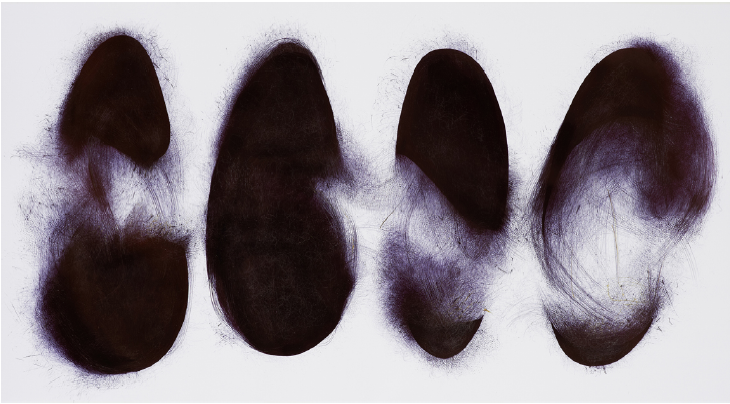| Galerie Kashya Hildebrand is pleased to present emerging artist Chihiro Kabata’s first solo show with the gallery and the first presentation of her work in Switzerland. For the last several years, Kabata has attempted the paradoxical task of drawing something invisible or something that cannot be seen. Adrift in the Dark uses the experience of walking through a dark forest lit by only the softest of moonlight, where shadowy figures come into being in the in-between space of the imagination and reality, to underscore this idea of bringing forth the imperceptible. In viewing her works, there is an initial attraction to the abstract forms and shining surfaces. Yet a closer inspection reveals the thin, individual lines of a ballpoint pen that have been layered, tangled up in a chaotic mass. Like the indiscernible movement of fog, the ink seems to take on shape. Rather than absorbing the viewers, its mirror-like reflection turns back on us, calling on us to participate in the creative act by stimulating our imagination.
In this exhibition, Kabata’s paintings are dominated by shapes created by the repetitive action of her ballpoint pen on inkjet paper. More than 10 years ago, her high school teacher asked her to use a pen to draw a line the length of a marathon (42.195 km). The final result was an accumulation of lines that filled the paper with deep impressions, giving a shine to the surface. In the process of this exercise, Kabata saw how the ink transformed the paper, allowing it to gleam like metal. Unlike paint on a brush that needs constant replenishment, or a pencil that need to be sharpened, a ballpoint pen does not need to be refilled during the production of a work, permitting her to keep her body in motion in the creative process and incorporate that motion into the work. She builds up numerous, long, repetitive strokes to fill the surface of the picture, employing her entire body and her strength. For her, there is a visceral experience in this wild dance of fine lines indenting the gloss of the flat, smooth veneer produced by the ballpoint pen.
The density of the ink invites an immersion into or participation in the work, as the sheen of the ceramic-like texture reflects both the viewer and surrounding environment. At the same time, the work references the physicality of the artist’s body in the creation process in For Kabata, these vivid traces of the lines do not demarcate a space but become an abstract tool for expressing emotion. Meaning is generated by the viewer’s mind and imagination outside of the lines and beyond their shapes. |
